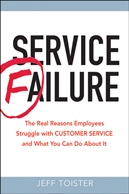 Service makes a difference when mattress shoppingMy wife, Sally, and I recently went shopping for a new mattress. We visited three stores that had the same products, similar prices, but vastly different levels of customer service. Guess which one we went with? Once again, proof that customer service drives sales in a retail environment.
Service makes a difference when mattress shoppingMy wife, Sally, and I recently went shopping for a new mattress. We visited three stores that had the same products, similar prices, but vastly different levels of customer service. Guess which one we went with? Once again, proof that customer service drives sales in a retail environment.
Last Place: Nightmare service
The worst example came at a mattress store near our home. As we walked through their door, we heard a guttural, "Howyaguysdoin?" from across the store. We both looked in that direction but couldn't tell who it came from since nobody was looking our way. After a minute or so, a woman approached us and revealed herself as our greeter by repeating, "Howyaguysdoin?"
If you haven't purchased a mattress in awhile, the process generally involves lying down on a bunch of mattresses and trying to imagine how comfortable you'd be sleeping on each one. Our salesperson made this fairly impossible because she never stopped talking. She told us about the great deals they were offering each mattress, about the cutting-edge technology integrated into the designs, and then somehow segued into her personal medical problems. None of those topics had anything to do with whether we'd get a good night's sleep on a particular mattress, and her medical history threatened to give us nightmares.
I'm sorry life dealt you a rough hand, lady, but that approach was a huge turn-off.
Distant 2nd: Slow service, dirty ceilings
We also visited a major department store where our salesperson was nice, but he was too busy to be helpful. We had to wait a few minutes while he served another customer, which wasn't so bad, but after we caught his attention it was hard to keep it. He left us repeatedly to serve other people while we were trying out various mattresses and discussing their pros and cons. Each time he left us, it made us less enthusiastic about shopping there. It also gave us time to notice things like their incredibly dirty ceiling.
Holy cow, that ceiling was gross! Seriously, store, lie down on one of your mattresses and look up at your disgusting ceiling and tell me if you feel restful.
The Winner: Dan at Sleep Train
Our winning salesperson was Dan at Sleep Train. The Sleep Train store was nicely organized with sparkling clean ceilings, so the deck was already stacked in their favor. However, Dan really nailed the customer service aspect of the sales process. Here are just a few things he did right:
- He greeted us immediately and introduced himself.
- Dan asked questions to get to know us and our needs.
- He encouraged us to try out various mattresses and adjusted the models he showed us based on our feedback (too hard, too soft, that sort of thing).
- There was silence, glorious silence, while we tried each mattress, but Dan remained nearby to immediately answer our questions.
- Dan didn't discuss price until we had picked our top choices. He realized that price was irrelevant if the bed was uncomfortable.
Service Pointers
In retail, service can have a huge impact on sales, especially on bigger ticket items. Here are just a few take-aways from our mattress-buying experience:
- Train your sales staff to first identify their customers' needs and tailor their pitch accordingly.
- Literally see things from your customers' perspective so you won't miss problems, like dirty ceilings in a mattress store, that are costing you sales.
- Consistently remind your sales staff that their job is to solve their customers' problems, not dump their problems on their customers.
 Jeff Toister
Jeff Toister  Monday, June 4, 2012 at 11:00AM |
Monday, June 4, 2012 at 11:00AM | 





